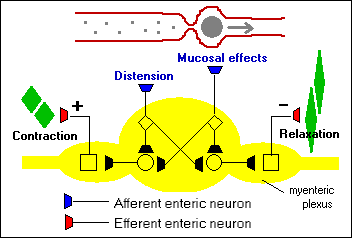VIVO Pathophysiology
Physiology of Peristalsis
Peristalsis is a distinctive pattern of smooth muscle contractions that propels foodstuffs distally through the esophagus and intestines. It was first described by Bayliss and Starling (J Physio (Lond) 24:99-143, 1899) as a type of motility in which there is contraction above and relaxation below a segment being stimulated. Peristalsis is not affected to any degree by vagotomy or sympathetectomy, indicating its mediation by the intestine's local, intrinsic nervous system.
Peristalsis is a manifestation of two major reflexes within the enteric nervous system that are stimulated by a bolus of foodstuff in the lumen. Mechanical distension and perhaps mucosal irritation stimulate afferent enteric neurons. These sensory neurons synapse with two sets of cholinergic interneurons, which lead to two distinct effects:
- One group of interneurons activates excitatory motor neurons above the bolus - these neurons, which contain acetylcholine and substance P, stimulate contraction of smooth muscle above the bolus.
- Another group of interneurons activates inhibitory motor neurons that stimulate relaxation of smooth muscle below the bolus. These inhibitor neurons appear to use nitric oxide, vasoactive intestinal peptide and ATP as neurotransmitters.

Send comments to Richard.Bowen@colostate.edu
